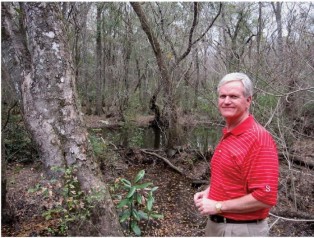Feature Friday, from a story written by Frank McIntosh.
A friend of Dan Jeter’s in the forestry and pine straw business had been after him for a while to buy a farm. He had shown Dan a few “cutovers” that didn’t appeal, but then called and told Dan he “had to see this one.”
The tract was one of the seven parcels—a 147-tract in Colquitt County, GA. that particularly appealed to Dan. It was not too big for him to manage and had lots of bottomlands that he knew would be home to lots of “woodies” and other wildlife to hunt and just to enjoy.
Dan’s brother had put conservation easements in place in North Carolina and Southwest Georgia, so Dan was drawn to the idea of the benefits provided to donors as well as the idea of conservation.
“At some point you morph from financial to aesthetic preservation. When I signed the
conservation easement, I felt such a sense of happiness and accomplishment.” This emotion is seconded by Dan’s wife, Felicity, who expresses her feelings about land protection simply, “Why do we have to develop everything?” While the recent slump has slowed things a bit, Jeter notes that at one point not long ago there were seventeen different development projects before the local planning board.
Jeter also reports that “one of the pluses” in dealing with a land trust on a conservation easement is the care that is taken to ensure that valuable productive lands remain in production, but that the use of the land ensures that the special natural areas are not damaged by those uses and that extra protection is provided.
The Jeter conservation easement allows silvicultural and agricultural use on its uplands. Part of that land, 32 acres, is now in a longleaf restoration project that features locally grown longleaf saplings. The expansive bottomlands comprising much of the property are designated a Special Natural Area and will be preserved in their current condition except for incidental removal of invasive species and diseased vegetation.
The sloughs running down to Bridge Creek (so named for the old tramway trestle that crossed the creek, parts of which remain in the creek today) abound with mature hickories and white oaks. Jeter noted that the creek is good fishing, too—he allows neighbors onto the property to fish for red breast and bream.
Jeter, who mentors school children through the local Communities in Schools program, feels strongly about the role of education in shaping lives. He hopes that the property will provide an opportunity for his children and grandchildren to connect with “the way the land was for us and our forebears.”

Leave a comment